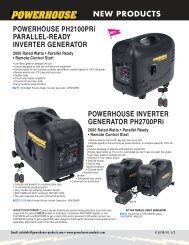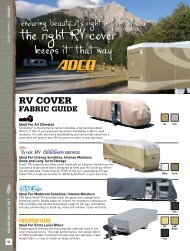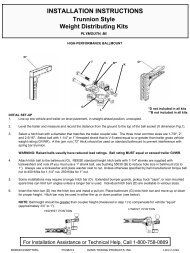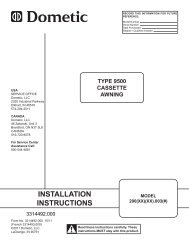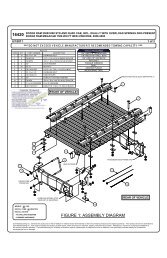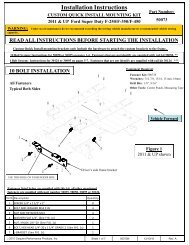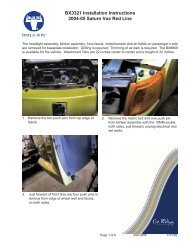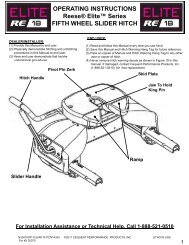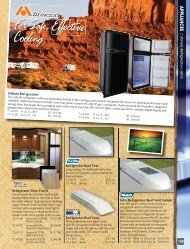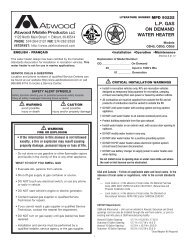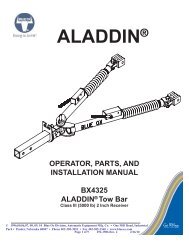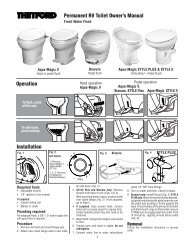dc refrigerators 12/24 volts installation and owner's manual
dc refrigerators 12/24 volts installation and owner's manual
dc refrigerators 12/24 volts installation and owner's manual
You also want an ePaper? Increase the reach of your titles
YUMPU automatically turns print PDFs into web optimized ePapers that Google loves.
NORCOLD AC/DC Models - Two Year Limited Warranty PolicyNorcold, Inc. warrants that when properly installed <strong>and</strong> placed under normal service <strong>and</strong>use its refrigeration equipment is free from defects in material <strong>and</strong> workmanship for twoyears commencing from the original date of purchase of the new equipment.Limitations of Warranty1. This Warranty is the only warranty for a Norcold AC/DC refrigerator. This Warrantydoes not extend to glassware, electric light bulbs, <strong>and</strong> replaceable fuses.2. This warranty does not apply to parts <strong>and</strong> assemblies that have been subjected tomisuse, improper <strong>installation</strong>, abnormal service, transit damage, recharging of coolingsystem, accident, fire, improper repair, tampering or abuse.3. Irrespective of the nature of the warranty protection offered or claimed, the period ofwarranty shall in no case extend beyond two years commencing from the original dateof purchase of the new equipment.Limitation of Remedy1. The responsibility of NORCOLD under this or any warranty is limited to the repair orreplacement (at NORCOLD’S option) of the defective part or assembly.2. In no event <strong>and</strong> under no circumstances shall NORCOLD be responsible under thisLimited Warranty for any other charge whatsoever, including but not limited to chargesor claims for labor, lost business, lost time, lost profits, loss of use, or any kind ofincidental or consequential damages, however denominated or described. The remedyunder this warranty is limited to repair or replacement.3. Some states do not allow the exclusion or limitation of incidental or consequentialdamages, so the above exclusion may not apply to you.Disclaimer of Other WarrantiesThis Warranty is expressly in lieu of all other warranties either expressed or implied. Allother warranties, expressed or implied, including any warranty of merchantability or fitnessfor a particular purpose, are hereby disclaimed <strong>and</strong> excluded.Legal RightsThis Warranty gives you specific legal rights, <strong>and</strong> you may have other legal rights whichvary from state to state.2
Safety AwarenessRead this <strong>manual</strong> carefully <strong>and</strong> underst<strong>and</strong> the contents before you install the refrigerator.Be aware of possible safety hazards when you see the safety alert symbol on therefrigerator <strong>and</strong> in this <strong>manual</strong>. A signal word follows the safety alert symbol <strong>and</strong> identifiesthe danger of the hazard. Carefully read the descriptions of these signal words to fullyknow their meanings. They are for your safety.WARNING: This signal word means a hazard, which if ignored, can causedangerous personal injury, death, or much property damage.CAUTION: This signal word means a hazard, which if ignored, can cause smallpersonal injury or much property damage.Model No. <strong>and</strong> Serial No.The model <strong>and</strong> serial number are on a label which is inside the refrigerator on the leftside <strong>and</strong> on the cover of this <strong>manual</strong>.OperationThis refrigerator is made for refrigerating purposes <strong>and</strong> operates on a <strong>12</strong>/<strong>24</strong> volt DCpower supply when installed as written in this <strong>manual</strong>.CAUTION: Never store combustible materials near the refrigerator. Storingcombustible materials near the refrigerator creates a safety hazard <strong>and</strong> alsodecreases the ventilation of the cooling system which decreases the refrigeratorperformance.Do not touch the evaporator or other metal parts inside the refrigerator cabinet withwet h<strong>and</strong>s because they can freeze to the refrigerator.Always disconnect all power sources from the refrigerator when doing routinemaintenance. Have service work done only by a qualified service technician.The refrigerator temperature is controlled by a thermostat, located on the panel above thedoor. A green power light, located on the panel comes on when the refrigerator is “ON”.Number “1” is the warmest <strong>and</strong> number “5” is the coldest thermostat position. Forefficient operation, change the thermostat according to the types of food stored <strong>and</strong> theambient temperature.If you are not going to use the refrigerator for an extended period of time, put the thermostatto the “OFF” position <strong>and</strong> open the door so the latch pin is in the storage position.(See Art01520).3
Over Heating Shut-off Device OperationOperating the refrigerator in high ambient temperatures can over heat the cooling unit an<strong>dc</strong>ause premature failure of the compressor. (See the label inside the refrigerator.)To protect the cooling unit from over heating, the refrigerator will automatically shut-off whenthe vehicle air temperature is higher than 110° F. If shut off occurs, an audible alarm tone (anintermittent beeping) operates from the refrigerator.To stop the audible alarm tone <strong>and</strong> restart the refrigerator, turn the thermostat counterclockwiseto the “OFF” position <strong>and</strong> then clockwise to the desired thermostat position.The refrigerator will not restart until the air temperature is lower than 110° F.Protection SystemYour refrigerator has an over current protectionsystem in the electronic circuit to prevent damage tothe inverter which may occur due to a reverse polarityconnection.If the refrigerator does not operate <strong>and</strong> the greenpower light does not come on, check the fuse,which is located on the side of the inverter case, <strong>and</strong>the polarity of the DC power supply. If the <strong>refrigerators</strong>till does not operate, another problem can exist inthe inverter. Have an authorized Norcold ServiceCenter check the refrigerator.Cleaning <strong>and</strong> DefrostingDefrostingIt is normal for frost to collect on the freezer plate inside the refrigerator. Excess frostdecreases the cooling performance of the refrigerator. Defrost the refrigerator as necessary.CAUTION: Do not use sharp objects, a hair dryer, a heat gun, etc. to defrost therefrigerator. Damage to the interior of the refrigerator can occur.- Turn the thermostat to “OFF”.- Remove all food from the refrigerator.NOTE: Defrosting the refrigerator makes excess water inside the refrigerator.- Put dry towels (etc.) inside the refrigerator to absorb the excess water.4
- Put trays of hot water in the freezer until the frost is melted.- Empty the drip tray.- Remove the wet towels (etc.) <strong>and</strong> dry the inside of the refrigerator- Turn the thermostat to the desired setting.- Put the drip tray <strong>and</strong> all food in the refrigerator.CleaningA good time to clean the refrigerator is just after you defrost it.Clean the inside of the refrigerator as often as necessary to avoid food odors:- Remove all food from the refrigerator.NOTE: Do not use abrasive cleaners, chemicals, or scouring pads because they c<strong>and</strong>amage the inside of the refrigerator.- Wash the inside of the refrigerator <strong>and</strong> the door gasket with a solution of liquid dishdetergent <strong>and</strong> warm water.- Rinse with clean water <strong>and</strong> dry.- After cleaning, put a thin coating of petroleum jelly on the hinge side of the gasket tokeep it soft <strong>and</strong> to prevent it from rolling.Battery MaintenanceOver cooling drains your battery- When the ambient temperature is between 70° <strong>and</strong> 90° F, keep the thermostat at the “3“position to avoid an excessive drain of the battery. When making ice, or storing frozenfoods, turn the thermostat to the coldest setting “5“.Maintain the batteryIf the charge of your battery is not sufficient, the cooling performance of your refrigeratordecreases.CAUTION: Only use a “quick charger” on the battery if the thermostat is turned to“OFF”.5
Check the Battery charge LevelA fully charged battery will have a specific gravity reading of between 1.260 <strong>and</strong> 1.280. Thebattery voltage is best indicated when the refrigerator is “ON” <strong>and</strong> the battery charging systemis “OFF”. Charge the battery when the specific gravity reading is less than 1.200.For your referenceThe wiring diagram shown below is recommended for dual battery hookup (SeeArt01516).InstallationThe refrigerator should be located <strong>and</strong> secured on a solid surface in the vehicle.Before installing the refrigerator into the opening, make sure the DC supply is properlyconnected. In many cases, the DC supply can be connected from outside the vehicleby means of the baggage or access door.Measure the opening to determine if you have proper clearance for <strong>installation</strong>.Additional insulation space around the refrigerator is not necessary.6
Be sure the refrigerator is not in direct sunlight or near a gas stove, a heater, or otherheat-generating appliances. Avoid installing your refrigerator close to warm water linesor warm air ducts.Your refrigerator was thoroughly cleaned before shipment from the factory.It is advisable, however, to clean the interior once more before using. Wipe the interiorwith a cloth <strong>and</strong> warm water. Then wipe with a dry cloth.VentilationSufficient ventilation (airflow) over the rear mounted condenser of the refrigerator isnecessary for the refrigerator to operate correctly (See Art01582).* NOTE: The fan will operate only whenthe ambient temperature ishigher than approximately 95° F.CAUTION: Do not remove thebottom rails from the refrigeratorcabinet. The rails supply spaceunder the refrigerator that is necessaryfor correct ventilation.If you do not make sure that theventilation is correct, a shortenedrefrigerator life expectancy, poorrefrigeration, continuous operation,accelerated battery discharge <strong>and</strong> avoid warranty will result.Installation OptionsInstall a decorative door panelNOTE: The decorative door panel must be4 mm or less in thickness.1. Remove the door from the refrigeratorby removing the two (2) bolts that attachthe door hinge to the bottom of therefrigerator (See Art01583).7
2. Remove the panel retainer by removingthe two (2) screws that attach the panelretainer (See Art01511).3. Gently pull the door panel out of thedoor (Art015<strong>12</strong>).4. Push a new door panel into the doorslot.CAUTION: Do not overtighten thescrews <strong>and</strong> bolts.5. Put the panel retainer in the originallocation <strong>and</strong> attach with two (2) screws.6. Put the door in the original location <strong>and</strong>tighten the two (2) bolts.Reverse the door swing:1. Remove the door from the refrigeratorby removing the two (2) bolts that attachthe door hinge to the bottom of therefrigerator2. Remove the two (2) bolts that attach theupper hinge.3. Remove the bolt that attaches the doorlatch plate to the top of the refrigerator(See Art01513).4. Remove the upper hinge <strong>and</strong> the doorlatch plate from the refrigerator.5. Attach the upper hinge <strong>and</strong> the doorlatch plate to the opposite sides of therefrigerator.8
6. Move the latch to the opposite side ofthe door (See Art01514):- Remove the screw that attaches thehinge insert to the door.- Remove the hinge insert, the latchh<strong>and</strong>le, <strong>and</strong> the coil spring from thedoor.- Pull the latch h<strong>and</strong>le pin out of therecess in the latch h<strong>and</strong>le.- Move the latch h<strong>and</strong>le pin to oppositeside of the latch pin (See Art01515).- Turn the latch h<strong>and</strong>le upside down <strong>and</strong>push the latch h<strong>and</strong>le pin into therecess of the latch h<strong>and</strong>le.- Make sure the angled top facesthe door latch plate.- Assemble the coil spring, the latchh<strong>and</strong>le, <strong>and</strong> the hinge insert into theopposite side of the door.- Install <strong>and</strong> tighten the screw thatattaches the hinge insert to the door.7. Put the door onto the refrigerator8. Install <strong>and</strong> tighten the two (2) screwsthat attach the door hinge to the bottomof the refrigerator.9
Connect the <strong>12</strong> <strong>volts</strong> DC supplyThis refrigerator operates on <strong>12</strong>/<strong>24</strong> <strong>volts</strong> DC current from a battery.CAUTION: Only connect the refrigerator directly to the battery. Because theyoften generate high voltage pulses <strong>and</strong> cause transistor defects in the inverter, noother switches, lead wires, or electrical equipment should share the wiring betweenthe refrigerator <strong>and</strong> battery.When using either a converter or a battery charger, make sure that they are connected inparallel between the battery <strong>and</strong> the refrigerator. Do not use a converter or battery chargerto supply the DC power directly to the refrigerator because these two devices do notsupply filtered DC power (See Art01521).As the distance from the vehicle battery to the refrigerator increases, the correct AWG wiresize also increases. If he wire size is too small for the distance, a voltage drop occurs.The voltage drop decreases the cooling performance of the refrigerator.1. Norcold recommends that you use the following wire <strong>and</strong> fuse sizes:- Measure the distance from the vehicle battery to the refrigerator:- If the distance is less than <strong>12</strong> feet, use 16 AWG wire <strong>and</strong> a 10 Amp fuse.- If the distance is between <strong>12</strong> <strong>and</strong> 20 feet, use 14 AWG wire <strong>and</strong> a 10 Amp fuse.- If the distance is more than 20 feet, use <strong>12</strong> AWG wire <strong>and</strong> a 10 Amp fuse.10
- Twist the lead wires to reduce the radio interference <strong>and</strong> induction of a high voltagesurge from the outside (See Art01518).2. Connect the DC power supply (SeeArt01509):- Remove the two (2) screws that attachthe junction cover.- Remove the junction cover.- Put each of the two (2) wires from thebattery through the ferrite core.- Make a loop of the two (2) around <strong>and</strong>back through the ferrite core.- Put the two (2) wires through thebushing of the junction cover.- Push the DC input wires onto the DCinput terminals.- Refer to the positive (+) <strong>and</strong>negative (-) markings to make surethat the connections are correct.- Attach the junction cover with the two(2) screws.- Put the two (2) wires through the wirestrain relief.- Attach the wire strain relief to the refrigerator cabinet with the self-tapping screw.11



